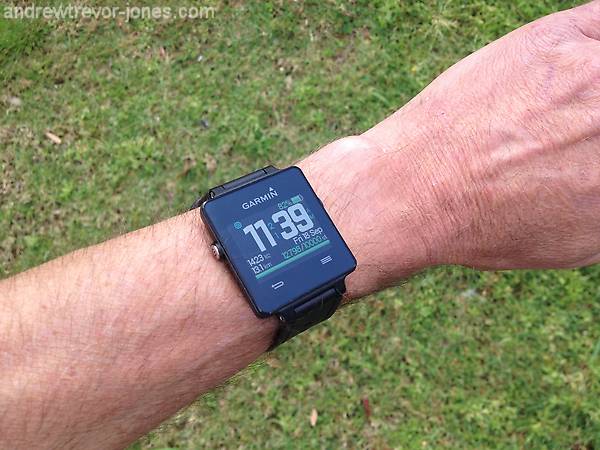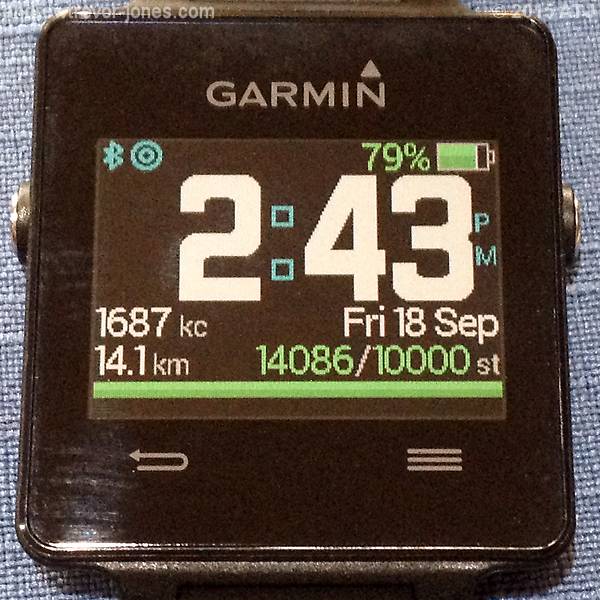
Original: Tuesday 22 September 2015 Update: Friday 25 September 2015
I've had my Garmin vívoactive for a week now and I really like it. It is so much better than the Mio FUSE in so many ways and I can use it instead of my Garmin Forerunner 310XT for running and biking. I'm comparing the vívoactive to the Mio FUSE not because they are in the same class of trackers but simply because the FUSE is the only other activity tracker I have used.
It is comfortable to wear and easy to read the time even without my glasses. In sunlight I can even read the smaller print.
I have rather thin wrists but the watch seems to fit OK. It is more stylish than the Mio FUSE and, unlike the FUSE, I don't have to press any buttons to read the time.

The watch needs to be used with a supported mobile phone and that phone needs to be running the mobile version of Garmin Connect. The data is synced between the watch and Garmin Connect on the phone using Bluetooth.
The Garmin Connect mobile app doesn't store data locally so you need to be connected to the Internet to use it and to sync. This may be a limitation when travelling. I will soon see. At least the data is backed up immediately, unlike Mio where it only resides on the phone and is never backed up.
The Garmin Connect mobile app allows you to look at your data (when connected to the Internet) and you can also see your data on the web version of Garmin Connect. The amount of data available is quite impressive and you can do quite a bit of analysis.
There have been some complaints online about the Bluetooth connection with phones but have had no problems connecting to my iPhone 4S (iOS 8.4.1). The only time I have lost the Bluetooth connection is when the phone was out of range.
Garmin Connect and MyFitnessPal vsan share information between each other. Garmin Connect sends my step data and the calories/kilojoules burned in activities (workouts) to MyFitnessPal. MyFitnessPal sends food data to Garmin Connect. Each app will show me how I'm doing each day with my calorie/kilojoule balance. It is automatic once I set up the connection.
It tracks my steps much like any other wrist worn device. It has an accelerometer and uses the information from this to approximate steps. It is not an exact science and will never be entirely accurate.
I seem to be tracking more steps with the vívoactive than I did with the FUSE. I wore both for one day and the vívoactive recorded 15,812 steps and the FUSE 12,784. For specific activities the vívoactive and FUSE seem pretty close. For a dog walk, I got 4,129 steps for the FUSE and 4,078 for the vívoactive. For a 30 minute run, it was 4,991 steps for the FUSE and 5,190 for the vívoactive. This suggests that the vívoactive may be recording other arm movements as steps that the FUSE doesn't.
One day I clocked up 380 steps while driving to a dive site. It was a 72 minute drive, I drive a manual and change gears with the hand I wear the vívoactive so I suspect it is picking up on the arm movements while changing gear. On another drive of just under an hour, I clocked up 221 steps. Riding in the train I clock up few or no steps, so it isn't the motion of the vehicle. These extra steps are quite small and may help to make up for the steps that don't get countered when walking from the car to the dive entry point (as I don't wear the vívoactive for the dive).
If the vívoactive thinks I haven't been active for the last hour it vibrates and tells me to move. To reset it I have to get up and walk. It appears I need to walk between 150 and 200 steps before it will reset. If I don't move when it tells me to, it will remind me again - and I think I have to walk even further to reset it.
The FUSE did not have this feature. At the moment I like it but I wonder if I will eventually get sick of it. Time will tell.
The automatic sleep tracking is great even if the level of detail is not. Basically, it detects when you go to sleep and keeps track of deep sleep, light sleep and awake.
I don't know how accurate it is. I suspect it has some problems. For example, I know one morning I woke at around 5:20am and lay in bed until nearly 6. It had me waking at 5:20am but then light sleep until 5:56am which was clearly not correct. However, on another day I woke not long after 4am and couldn't get back to sleep but stayed in bed. It had me waking at 4:16am which is about right. It has also tracked me falling asleep in front of the TV.
The FUSE does not have this feature although it has been promised.
The vívoactive can be set to redisplay notifications from my phone on the watch. It will only work if the phone and watch are connected by Bluetooth. The notifications include anything that displays on the lock screen of the phone or ends up in Notification Center. I get notifications of emails, text messages, Facebook messages and even incoming calls on my phone. I can even press on the watch to have the phone answer (or reject) the call. This is pretty cool, especially when the watch vibrates and tells me there's a call even before I hear the phone ring.
One of the nice features of the vívoactive is the ability to use different watch faces, apps and widgets.
The default watch face is alright but I have since installed BigTime. This gives me the time which is large enough for me to read without my glasses even in low light, plus a wealth of other information including the battery status, my step progress and the inactivity reminder. I highly recommend this watch face.

The vívoactive comes with apps for outdoor and indoor (treadmill) running, walking and biking; swimming and an app to Find My phone. The running app only allows 3 fields of data per screen and there are 3 screens through which I can scroll. I had my Forerunner 310XT set up with 4 data fields displaying at once for my runs: Elapsed Time, Heart Rate, Current Pace and Average Pace. It is possible for me to set the FUSE to show the heart rate all the time and so I could have the 3 fields on the first screen set to Current Pace, Elapsed Time and Average Pace but I have instead installed a BETA app called Run Fields 4/6/9. This allowed me to have the same 4 fields as I have on the Forerunner 310XT. I am hoping the developer will release a bike version of this app.
There are a few widgets on the vívoactive by default. Smart notifications is a widget and there is also one for calendar, weather, remote control of music on the phone, and step tracking. The calendar widget shows me events on my calendar for today. There are other widgets available in the ConnectIQ store but I haven't looked into them as yet.
I have a number of ANT+ devices that I used with my Forerunner 310XT: Heart rate monitors (chest strap and the Mio FUSE), Footpod, Bike speed/cadence sensor. All these work fine with the vívoactive. I have used the Mio FUSE as my heart rate monitor for walking, running and cycling. I have also used the Bike speed/cadence sensor for a bike ride.
Garmin claim the battery will last up to 3 weeks in watch/activity mode. That seems a bit of a stretch but over a week seems easy. It is important to turn the GPS off in the settings. It was on by default when I got mine and the battery nearly drained overnight. Once I have switched it off the battery level hardly moves except when I do a GPS based activity.
It's only been a week but I am very happy with the vívoactive. I can highly recommend it as an all-day watch, activity tracker and training watch. The Mio FUSE will now be relegated to a heart rate monitor.
Please leave Feedback if you have any comments or questions about this blog entry.